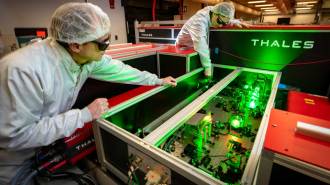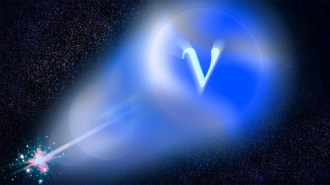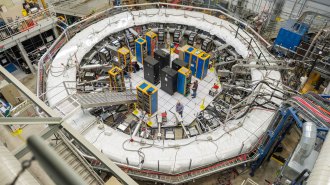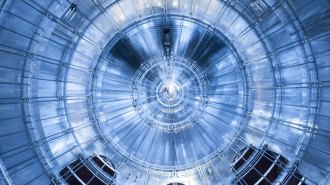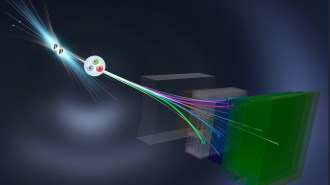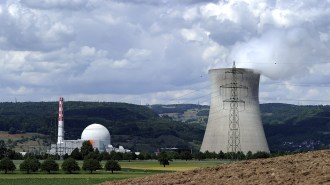New data give clearer picture of Higgs boson
Physicists scrutinize latest LHC results to refine knowledge of boson’s properties
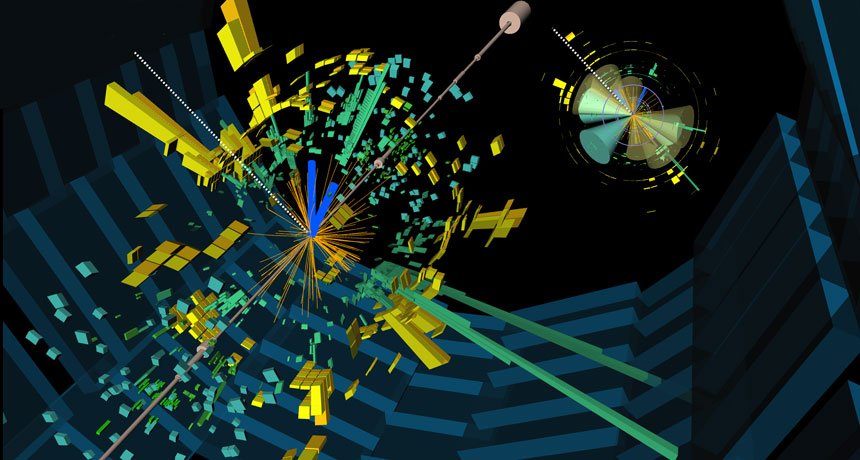
HIGGS SLEUTHS Scientists at the Large Hadron Collider are using their new higher-energy data to study the Higgs boson. This visualization of the ATLAS experiment shows an event possibly containing a Higgs boson produced in combination with two top quarks, one of many new processes scientists are looking for.
CERN
- More than 2 years ago
CHICAGO — It’s a Higgs boson bonanza for particle physicists, who are capitalizing on the newest data from the Large Hadron Collider to delve more deeply into the particle’s properties. Scientists are keeping a keen eye out for any deviations from the standard model of particle physics, the overarching theory that describes elementary particles and their interactions.
The Higgs boson’s discovery in 2012 (SN: 7/28/12, p.5) filled in the last remaining piece of the standard model, helping to explain how elementary particles obtain their mass. With the newest data from the LHC, near Geneva, scientists have nailed down the Higgs’ properties at the LHC’s newly boosted energy. The results “strengthen the identity card of the Higgs,” says Tiziano Camporesi, spokesperson for CMS, one of the LHC experiments. Camporesi discussed the new results on August 8 at the International Conference on High Energy Physics.
The collider is now smashing protons together with 13 trillion electron volts of energy — 60 percent higher than before. The LHC has spit out more Higgs bosons at these higher energies than it did during the time it ran at its lower energy. With the new data, scientists have confirmed properties of the Higgs that were previously measured at lower energies, such as its mass (about 125 billion electron volts) and its spin (0) — a quantum version of angular momentum.
But physicists are digging even deeper, in hopes of uncovering anomalies that might lead to explanations for phenomena the standard model can’t account for — such as the unidentified dark matter pervading the cosmos or the cosmic preponderance of matter over antimatter.
Sorting out the assortment of processes that generate a Higgs is first on the agenda. At higher energies, certain rare processes become more prominent. In particular, scientists are searching for a Higgs boson produced alongside two top quarks. Top quarks are the heaviest variety of the six quarks, which form larger particles like the proton and neutron. Scientists have seen hints of the process, though not enough to meet the stringent requirements for a definitive detection. ATLAS scientists calculate a chance of only 3 in 1,000 to observe such hints by chance, if the process does not occur.
Another way to probe the Higgs is by detecting new ways it can decay. Scientists have seen the Higgs decay into two photons — or particles of light — for example. But according to theory, Higgs bosons should decay over half of the time into bottom quarks, the second-heaviest type of quark. But bottom quarks are produced in plentiful numbers by other processes at the LHC, so sifting out evidence of Higgs bosons from the bottom-quark debris they produce is difficult. Definitive confirmation of the decay remains elusive. “That’s a place where we’re looking very hard in the new data,” says David Charlton of the University of Birmingham in England, the spokesperson of the ATLAS experiment at the LHC.
By comparing the results from the new, higher-energy data with earlier LHC results, physicists can study how these processes change with energy and whether they agree with theory. In the new dataset, everything seems in order.
Many theories aiming to patch the holes in the standard model predict additional Higgs bosons, and scientists are now searching for those heavier Higgs cousins. “Who’s to say there’s only one? There might be more,” says ATLAS researcher Carl Gwilliam of the University of Liverpool in England.
So far, the Higgs has passed all of scientists’ tests, staying steadfastly consistent with theoretical predictions. “Can it really be this simple?” Nigel Lockyer, director of the Fermilab physics laboratory in Batavia, Ill., asked in a media briefing. “When we sit around and drink coffee at night, that’s the kind of thing that we talk about.” Higgs research, he said, is far from complete.
